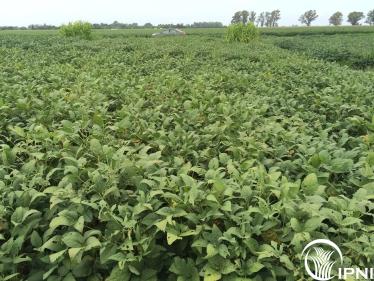01 Jun 2015
Breaking yield barriers in soybean: Preliminary results of the first year of experimentation at Oliveros - Argentina
Poster presentation at the 2015 Fertility Symposium

The field study has been established on November 2014 at the Experimental Station of INTA at Oliveros (Santa Fe, Argentina) (Table 1). The factors under study are: soybean maturity group, row spacing, planting date, and nutrient management (inoculation, P rate and time, S rate, B and Zn rates, N rate, placement, and time).
Table 1. Treatments at the EEA INTA Oliveros site. Argentina, 2014/15 season.
| Treatment | ||||
| Famer Practices (FP) | Comprehensive Fertilization (CF) | Production Intensity (PI) | Ecological Intensification (CF+ PI) | |
| Seed Treatment | Fungicide + Insecticide | |||
| Herbicide management | PRE + POST | |||
| Agronomic management | ||||
| Soybean maturity | DM 4970 | DM 4970 | LDC 4.7 | LDC 4.7 |
| Row Spacing | 52 | 52 | 26 | 26 |
| Fungicide Application | Yes | |||
| Planting date | 28 Nov | 28 Nov | 7 Nov | 7 Nov |
| Target seeding rate (seeds/ha) | 290,000 | 290.000 | 440,000 | 440,000 |
| Nutrient management | Standard | Advanced | Standard | Advanced |
| Inoculation | None | Single rate + PGR | None | Single rate + PGR |
| P (STP) in 2 x2 at seeding | NO | 20 kg P ha-1 | NO | 20 kg P ha-1 |
| P strategy | Without P | Broadcasted on July 2014 | Without P | Broadcasted on July 2014 |
| Sulfur | NO | 20 kg S ha-1 (Gypsum) | NO | 20 kg S ha-1 (Gypsum) |
| Micros (B + Zn + Mn) | 0 | B, foliar at R2-3 | 0 | B, foliar at R2-3 |
| Reproductive N (R4-5) | 0 | 50 | 0 | 50 |
- Biological N fixation will be determined using the 15N abundance method.
- “Rescue” irrigation was not needed.
Plots were harvested on mid-April, preliminary data is shown in Table 2.
Table 2. Grain yield, seed weight and seeds per m2 for the four treatments evaluated at Oliveros (Santa Fe, Argentina). 2014/15 season.
Farmer
Practices (FP) | Comprehensive Fertilization (CF) | Production Intensity (PI) | Ecological Intensification (CF+ PI) | |
Grain yield (kg/ha) | 5199 | 5491 | 5291 | 5495 |
Grain weight (g/1000 grains) | 180.4 | 190.8 | 161.8 | 165.3 |
Grains per m2 | 2880.6 | 2878.5 | 3269.9 | 3322.8 |
- On average, the four agronomic management and fertilization strategies yielded higher than 5200 kg ha-1, there were no significant differences among treatments or interaction effects of management practices and fertilization strategies.
- Intensive management (average of PI and CF+PI) increased the number of grains per m-2 respect to standard management (average of FP and CF) (P <0.01) by 14.5%. Nutritional management had no significant effect (P> 0.60) in this component.
- Grain weight increased by 4% in response to intensive fertilization (average of CF and CF+PI) compared to standard nutrient management (average of FP and PI) (P <0.04). However, standard practices (average of FP and CF) increased individual grain weight by 13.5% compared to intensive management (average of PI and CF+PI) (P <0.001).
- In summary, increases of 14% in the number of grains per effect of intensive management practices were offset by an increase of 13.5% in grain weight in the standard management. Comprehensive fertilization tended to increase grain yields but these increases were not statistically significant (+204 to 292 kg/ha).
Additional Resources
Poster Soybean Systems 2015 - FINAL.pdfSize: 0.34 MB
